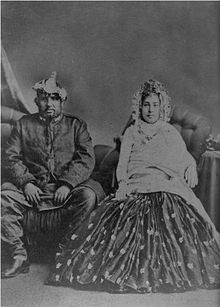Gajraj Singh Thapa
Colonel Gajraj Singh Thapa (Nepali: गजराज सिंह थापा) was the first person to establish tea plantation estates in Nepal. Around 1873, Thapa, son-in-law of Prime Minister Jung Bahadur Rana, was on a tour of Darjeeling.[1] He was impressed by the sight of the young tea plants and the taste of the drink he was offered everywhere he went. Upon his return to Nepal, he set up two plantations – the Ilam and Soktim tea estates, 103 acres (42 ha) each – and so began Nepal's tea industry.[2] Colonel Thapa was then the Governor General (Bada Hakim) of the eastern region of Nepal.[3][4] Translation of various signposts placed in Ilam (shown below), reads that the very first tea saplings planted by Thapa was received as a gift from the Government of China, it was gifted to his father-in-law prime minister Jung Bahadur Rana. According to the signpost the genus of tea planted in the estate were Camellia sinensis/Camellia Assamica/Camellia assamica sub sp Lasiocalyx or cambodensis.

Personal life[edit]
Thapa was born c. 1830 to Hemdal Singh Thapa. In 1860, he married Maharajkumari Badan Kumari Rana of Kaski and Lamjung, the eldest child of Sri Teen Jung Bahadur Rana. They had one son and four daughters. The son was Colonel Harka Jung Thapa.


Titles[edit]
- Colonel of the Nepal Army
- Governor General (Bada Hakim, बडा हाकिम) of Eastern Nepal.
References[edit]
- ^ Jane, Pettigrew; Richardson, Bruce (1 Feb 2006). The Tealover's Companion: A Guide to Teas Throughout the World. London: National Trust Enterprises Ltd. p. 142. ISBN 070780390X. Retrieved 30 September 2014.
- ^ "Nepal Origin Teas". G S Haly Company. Archived from the original on 29 July 2015. Retrieved 23 September 2014.
- ^ Jane, Pettigrew; Richardson, Bruce (1 Feb 2006). The Tealover's Companion: A Guide to Teas Throughout the World. London: National Trust Enterprises Ltd. p. 142. ISBN 070780390X. Retrieved 30 September 2014.
- ^ "Tea Evolution in Nepal". Antu Valley Tea. Retrieved 25 September 2014.

